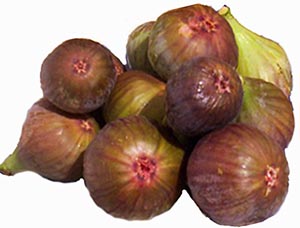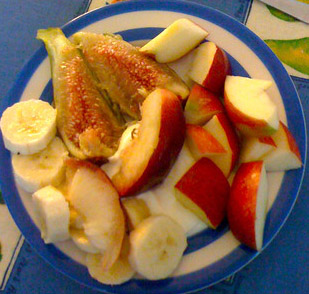Fig fruit Nutrition facts
Delicious, sweet fig fruit is one of the popular fruits enjoyed since ancient times. Fig is rich in natural health-benefiting phytonutrients, antioxidants, and vitamins. Entirely developed and ripe fig features bell or pear shape with succulent, juicy flesh inside. Dried figs, indeed, are a highly concentrated source of minerals and vitamins.
Botanically figs belong to the mulberry family (Moraceae), in the genus: Ficus.
Scientific name: Ficus carica.
 |
| Figs (Ficus carica). Note for pear-shaped, ripe fruits with smooth shiny surface. Photo courtesy: tenefire |
The fig tree is native to temperate regions of Asia Minor or Turkey, and today, grown as an important fruit of commerce in the eastern Mediterranean climates, US, and Spain. It is also cultivated as a fruit tree in the home gardens in many other regions as well. During each season, fig produces several hundreds of pear-shaped fruits twice a year, which vary in size, and color depending on the variety.
Interiorly, fig fruit features numerous tiny club-shaped ovaries extending towards the central hollow cavity. In their natural habitat, “caprifigs” are pollinated by tiny "gall wasp" (Blastophaga psenes) insect that enters flower clusters through a small opening at the apex.
Several cultivars of fig exist; some of the traditional varieties commonly grown in the USA are Brown Turkey, Conadria, Kadota, and Black mission. However, since the wasp does not exist in North America, most of these fruits develop by parthenogenesis (without pollination) and therefore, do not possess "true" seeds.
Health benefits of Figs
Fig fruit is low in calories. 100 g fresh fruits carry only 74 calories. However, they contain health-benefiting soluble dietary fiber, minerals, vitamins, and pigment antioxidants that contribute immensely towards optimum health and wellness.
Dried figs are an excellent source of minerals, vitamins, and antioxidants. In fact, dried figs possess higher concentrations of energy, minerals, and vitamins. 100 g dried figs provide 249 calories.
Fresh figs, especially black mission, contain polyphenolic flavonoid antioxidants such as carotenes, lutein, tannins, chlorogenic acid, etc. Their antioxidant value is comparable to that of apples at 3200 mol/100 g (Trolox equivalents).
Additionally, fresh figs contain adequate levels of some of the anti-oxidant vitamins such as vitamin, E, and K. Altogether these phytochemical compounds in fig fruit help scavenge harmful oxygen-derived free radicals from the human body and thereby protect us from cancers, diabetes, degenerative diseases, and infections.
Furthermore, research studies suggest that chlorogenic acid in the figs helps lower blood sugar levels and control blood glucose levels in type-II diabetes mellitus (adult-onset) conditions.
Fresh, as well as dried figs, contain healthy levels of a B-complex group of vitamins such as niacin, pyridoxine, folates, and pantothenic acid. These vitamins function as co-factors for the metabolism of carbohydrates, proteins, and fats.
Dried figs are excellent sources of minerals like calcium, copper, potassium, manganese, iron, selenium and zinc. 100 g of dried figs contain 680 mg of potassium, 162 mg of calcium, and 2.03 mg of iron. Potassium is an important component of cells and body fluids that helps control heart rate and blood pressure. Copper is required in the production of red blood cells. Iron is essential for red blood cell formation as well as for cellular oxidation. (Source: USDA National Nutrient Database).
| Principle | Nutrient Value | Percent of RDA |
|---|---|---|
| Energy | 74 Kcal | 4% |
| Carbohydrates | 19.18 g | 15% |
| Protein | 0.75 g | 1.5% |
| Total Fat | 0.30 g | 1% |
| Cholesterol | 0 mg | 0% |
| Dietary Fiber | 2.9 g | 7% |
| Vitamins | ||
| Folates | 6 µg | 1.5% |
| Niacin | 0.400 mg | 2.5% |
| Pantothenic acid | 0.300 mg | 6% |
| Pyridoxine | 0.113 mg | 9% |
| Riboflavin | 0.050 mg | 4% |
| Thiamin | 0.060 | 5% |
| Vitamin A | 142 IU | 5% |
| Vitamin C | 2 mg | 3% |
| Vitamin E | 0.11 mg | 1% |
| Vitamin K | 4.7 µg | 4% |
| Electrolytes | ||
| Sodium | 1 mg | 0% |
| Potassium | 232 mg | 5% |
| Minerals | ||
| Calcium | 35 mg | 3.5% |
| Copper | 0.070 mg | 8% |
| Iron | 0.37 mg | 5% |
| Magnesium | 17 mg | 4% |
| Manganese | 0.128 mg | 5.5% |
| Selenium | 0.2 µg | <1% |
| Zinc | 0.15 mg | 1% |
| Phyto-nutrients | ||
| Carotene-ß | 85 µg | -- |
| Lutein-zeaxanthin | 9 µg | -- |
Selection and storage
Avoid very soft, broken, bruised, fungus-inflicted fruits. Similarly, unripe green figs are bitter (astringent), and therefore, out of flavor and unappetizing.
Fig fruit perishes rather very quickly and should be eaten while fresh or else should be placed inside the refrigerator where it stays fresh for 2-3 days. Put them in a plastic or zip pouch and store them in the fridge set with high relative humidity. However, dried figs can stay for 6-8 months.
Fresh figs can be available all around the season; however, they are at their best from May through November. One may find fresh as well as dried figs in the markets. While buying fresh figs, look for uniform-sized, ready ones that are soft, emit a sweet, pleasant aroma.
Avoid very soft, broken, bruised, fungus-inflicted fruits. Similarly, unripe green figs are bitter (astringent) and therefore, out of flavor and unappetizing.
Fig fruit perishes rather very quickly and should be eaten while fresh, or else placed inside the refrigerator where it stays fresh for 2-3 days. Put them in a plastic or zip pouch and store them in the fridge set with high relative humidity. However, dried figs can stay for 6-8 months if packed in an air-seal container.
Preparation and serving tips
 |
| Fig, banana, and apple salad. Photo: Paul Downeye |
Figs must be allowed to ripen completely on the tree itself before picking. They can be enjoyed fresh, and after the artificial, or sun-drying.
To eat fresh fig, wash it in cold water and mop it dry gently using a soft cloth or tissue paper. One may eat fresh figs whole or peeled. If taken out from the cold storage, place in a bowl of water to bring them back to normal room temperature to enrich their taste and flavor.
Here are some serving tips:
Sweet, succulent fig fruit best enjoyed as it is without any addition/seasonings.
Fresh figs are an excellent addition to salads, in cakes and ice-creams.
Dried figs can be added to soup, stews and to enrich poultry, venison, lamb meat.
Dry figs are excellent additions to breakfast cereal, muffins, cakes, sandwiches, pies, and cheesecakes.
Enjoy marinated figs with raspberry sauce.
Safety profile
Fig leaf and unripe fruits produce white latex that can penetrate into the skin and can cause an unpleasant burning sensation. Fig latex contains several compounds like furocoumarins, 5-methoxypsoralen (5-MOP)...etc, which can elicit cell-mediated allergic reactions. If left untreated, it might lead to severe allergic eruptions on the exposed parts.
In some sensitive people, eating fig fruit may also elicit allergic reactions ranging from vomiting, diarrhea, and itching of skin and mucosa. Therefore, individuals with a history of allergy to figs may be advised to avoid eating them. (Medical disclaimer).
≻≻-Back to Fruits from Fig fruit. Visit here for an impressive list of all varieties of fruits with complete illustrations of their nutrition facts and health benefits.
≻≻-Back to Home page.
Further reading and Resources:
Stanford School of Medicine Cancer information Page- Nutrition to Reduce Cancer Risk.
USDA National Nutrient Database-dried figs.